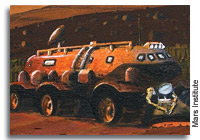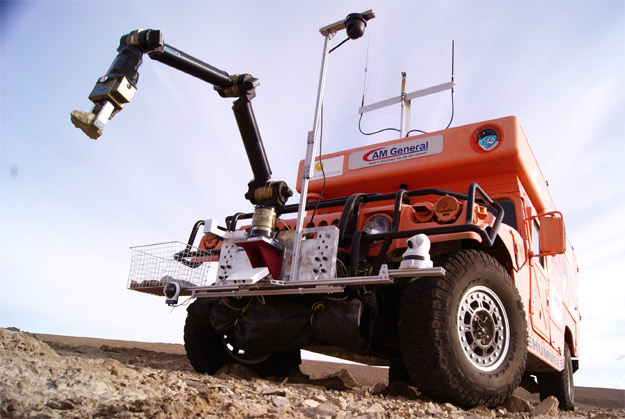Robotic Arm to Assist Future Astronauts in Sampling Asteroids, the Moon, and Mars from Pressurized Vehicles

Haughton-Mars Project Research Station, Devon Island, High Arctic, August 5, 2011 – An international team of space researchers from the Mars Institute and the space robotics company MDA Information Systems, Inc., has successfully completed a first series of field tests aimed at determining how future astronauts piloting a pressurized vehicle will be able to use a robotic arm to efficiently collect geologic samples on asteroids, the Moon, and Mars, without always needing to go out on spacewalks.
This study, the first field test of a robotic arm operated by a human from inside a pressurized rover simulator, was conducted as part of the Haughton-Mars Project (HMP), a multidisciplinary field research project based at the Haughton meteorite impact crater site on Devon Island in the High Arctic, viewed as an “analog” for the surface of asteroids, the Moon, and Mars. The impact-scarred, ice-scoured, and vegetation-free terrain at Haughton allows for realistic simulations of key aspects of science operations, including sample collection, on those planetary surfaces laden with impact-generated rubble.
For this summer’s exploratory field test, an existing MDA-developed robotic arm was integrated to the HMP’s Moon-1 and Mars-1 Humvee Rovers, which are used by the Mars Institute and NASA as stand-ins for future pressurized space exploration vehicles, and deployed in the field to simulate planetary excursions. “Small pressurized vehicles are central to future human planetary exploration. We are learning here on Earth how best to use them to maximize the science return of future human missions to asteroids, the Moon, or Mars”, says Dr Pascal Lee, Director of the Haughton-Mars Project and lead scientist for the pressurized rover robotic arm study. This year’s field test builds on an initial study led by Lee at HMP and funded by NASA’s Moon and Mars Analog Missions Activities (MMAMA) Program.
Pasadena, CA-based MDA Information Systems, Inc., the company that designed and built the highly successful robotic arms on NASA’s Mars Exploration Rovers (MERs) and the Phoenix Mars Lander, successfully deployed the MDA robotic arm system and newly-developed hardware and software interfaces to enable rock and soil sampling from the confines of a small pressurized vehicle simulator. “We are learning how to develop a new generation of collaborative robotic systems that will best assist humans in exploring a variety of planetary surfaces in the future” says Tom McCarthy, Business Development Director at MDA.
Because planetary bodies often present mostly loose rubble and soils at their surface rather than outcrops of bedrock, the research team has set out to determine if the use of a robotic arm system operated from the interior of a pressurized vehicle might be sufficient to satisfy a substantial portion of sample collection needs. Over 95% of lunar rock samples brought back from the Moon by the Apollo astronauts were found lying on the ground amongst impact-generated rubble and were collected with merely a scoop. “Along with a capable arm, we are developing the sensors and astronaut/robotic arm interface that will be easy to use and highly effective at allowing the collection of the best possible samples” says Sean Dougherty, MDA’s Mechatronics Engineering Group Supervisor and lead engineer for this year’s field test at HMP.
This year’s study shows that the use of a robotic arm by a trained member of a highly mobile pressurized vehicle’s crew can be very effective in allowing, within minutes, high value samples to be spotted, approached, retrieved, examined, and collected in IVA (intra-vehicular activity) mode, i.e., without the crewmember needing to go out on a spacewalk. The results obtained so far have potentially far-reaching implications for the design of future human mission architectures, as it suggests that the number, frequency, and duration of extravehicular activities (EVAs), or spacewalks, needed for sample collection could be reduced from earlier estimates if a robotic arm system is available on a pressurized exploration vehicle. This will increase crew safety, help reduce wear and tear on spacesuits, and also limit the crew’s exposure to space radiation, which is greater during spacewalks than when the crew remains inside the pressurized vehicle. Sampling via a robotic arm may also help address planetary protection concerns, i.e., the need to collect some samples without contaminating them by contact with even spacesuited crewmembers, and vice versa, the need to protect astronauts from some samples.
“While the human exploration of asteroids, the Moon, and Mars will still require frequent spacewalks to carry out detailed field observations, sample hard-to-access sites, and accomplish a variety other tasks, many areas on these bodies may be adequately investigated with crewmembers staying inside their pressurized vehicle and using only a robotic arm system to interact with the surface” explains Lee. The robotic arm research team hopes that lessons learned from this year’s field test in the Arctic and from upcoming campaigns will contribute to the design of future pressurized vehicles, such as NASA’s Multi-Mission Space Exploration Vehicle (MMSEV).
For more information, please visit www.marsinstitute.info or www.marsonearth.org or contact:
Mr Marc Boucher
CEO, Mars Institute
E-mail: marc.boucher@marsinstitute.net
Tel: (650) 641-0193
Tom McCarthy
Business Development Director, Robotics & Mechanisms
E-mail: tom.mccarthy@mdaus.com
Tel: (626) 296-1373, Ext. 184

Figure 1: The Haughton-Mars Project’s Mars-1 Humvee Rover, a simulator used by the Mars Institute and NASA to study pressurized vehicle operations for human space exploration, extends its robotic arm to collect a rock sample at Haughton Crater, Devon Island, High Arctic, under the supervision of MDA lead field engineer Sean Dougherty. (Photo Haughton-Mars Project-2011/Mars Institute/MDA/Pascal Lee)

Figure 2: A crewmember inside the Haughton-Mars Project’s Mars-1 Humvee Rover, a simulator used by the Mars Institute and NASA to study pressurized vehicle operations for human space exploration, succeeds in collecting a rock sample at Haughton Crater, Devon Island, High Arctic, using an MDA-developed robotic arm. (Photo Haughton-Mars Project-2011/Mars Institute/MDA/Pascal Lee).

Figure 3: The Haughton-Mars Project’s Moon-1 Humvee Rover, a simulator used by the Mars Institute and NASA to study pressurized vehicle operations for the future human space exploration of asteroids, the Moon, and Mars, extends an MDA-developed robotic arm to collect a rock sample at Haughton Crater, Devon Island, High Arctic. (Photo Haughton-Mars Project-2011/Mars Institute/MDA/Pascal Lee).

Figure 4: A future pressurized rover on Mars equipped with a robotic arm system for sample collection and examination (Painting by Pascal Lee).
About the Haughton-Mars Project
The Haughton-Mars Project (HMP) is an international multidisciplinary field research project centered on the scientific study of the Haughton meteorite impact crater and surrounding terrain on Devon Island, High Arctic, viewed as an “analog” for Mars, the Moon, asteroids, and other planetary bodies. The HMP supports a Science program focused on comparative studies between the Earth and other planetary bodies, and an Exploration program focused on developing and testing new technologies and strategies for the human and robotic exploration of space. Research at HMP is supported by NASA, the Canadian Space Agency, other government agencies in the US and Canada, and/or private partners. The HMP is managed by the Mars Institute, in collaboration with the SETI Institute. For more information, please visit:
www.marsonearth.org
About the Mars Institute
The Mars Institute is an international, non-governmental, non-profit research organization dedicated to advancing the scientific study, exploration, and public understanding of Mars. The Mars Institute conducts leading research in Mars Science and Exploration. The Institute also focuses on the Moon, Deep Space, Near-Earth Objects, and Mars’s moons Phobos and Deimos, viewed as key stepping-stones in the exploration of Mars. The Mars Institute is committed to conducting high quality peer-reviewed research and to sharing the knowledge and benefits of space exploration with students and the general public worldwide. The Mars Institute is headquartered at the NASA Ames Research Park, Moffett Field, CA. For more information, please visit:
www.marsinstitute.net
About MDA Information Systems, Inc.
MDA Information Systems, Inc. has been the leading developer and provider of planetary exploration robotics over the past decade. Past successes include the MER (Mars Exploration Rover) IDD (Instrument Deployment Device) on Spirit and Opportunity, and the robotic arm of the Phoenix Lander which excavated water ice at the Martian pole. NASA’s new Curiosity rover, to be launched late in the Fall of 2011, carries the largest planetary robotic arm ever developed by MDA Information Systems, Inc. In addition to its robotic arm pedigree, MDA Information Systems, Inc. supports many NASA programs and objectives through various flight actuator, mechanism and structures designs. For more information, please visit:
www.mdaus.com









